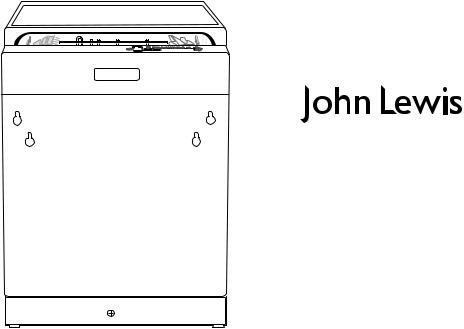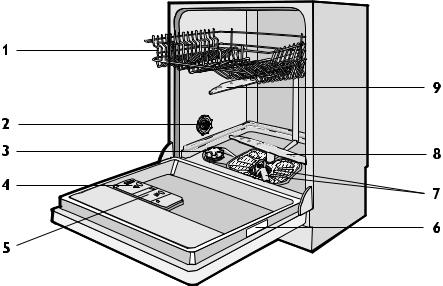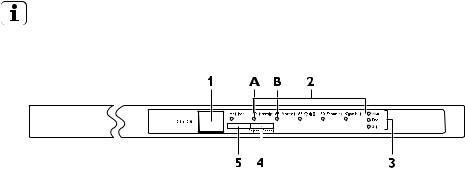John Lewis JLBIDW 1201 User Manual

JLBIDW 1201
Dishwasher
Instruction manual

 Important safety information
Important safety information
It is most important that this instruction book should be retained with the appliance for future reference. Should the appliance be sold or transferred to another owner, or should you move house and leave the appliance, always ensure that the book is supplied with the appliance in order that the new owner can get to know the functioning of the appliance and the relevant warnings.
These warnings have been provided in the interest of safety. You MUST read them carefully before installing or using the appliance. If you are unsure of the meanings of these warnings contact the John Lewis branch from which you purchased the appliance.
In the interest of your safety and to ensure the correct use, before installing and first using the appliance, read this user manual carefully, including its hints and warnings. To avoid unnecessary mistakes and accidents, it is important to ensure that all people using the appliance are thoroughly familiar with its operation and safety features. Save these instructions and make sure that they remain with the appliance if it is moved or sold, so that everyone using it through its life will be properly informed on appliance use and safety.
If you are unsure of the meanings of these warnings contact the John Lewis branch from which you purchased the appliance.
Installation
•This appliance is heavy. Care should be taken when moving it.
•Check the appliance r for any transport damage. Never connect a damaged machine. If the appliance is damaged contact your supplier.
•All packaging must be removed before use.
•Any electrical work required to install this appliance must be carried out by a qualified electrician.
•Any plumbing work required to install this appliance must be carried out by a qualified plumber.
•For safety reasons it is dangerous to alter the specifications or attempt to modify this product in any way.
•Never use the appliance if the electrical supply cable and water hoses are damaged; or if the control panel, work top or plinth area are damaged such that the inside of the appliance is freely accessible. Contact your local repair agent, in order to avoid hazard.
•All sides of the appliance must never be drilled to prevent damage to hydraulic and electric components.
2

For electrical and water connection carefully follow the instructions given in the specific paragraphs.
Child safety
•This appliance is designed to be operated by adults. Children should not be allowed to tamper with the controls or play with the appliance.
•Keep all packaging well away from children. There is a risk of suffocation.
•Keep all detergents in a safe place out of children’s reach.
•Keep children well away from the appliance when the door is open.
Correct use
•This appliance is only intended for washing household utensils suitable for machine washing.
•Do not put any solvents in the appliance. This could cause an explosion.
•Knives and other items with sharp points must be loaded in the cutlery basket with their points down or placed in a horizontal position in the upper basket.
•Only use products (detergent, salt and rinse aid) suitable for dishwashers.
•Avoid opening the door whilst the appliance is in operation, hot steam may escape.
•Do not take any dishes out of the appliance before the end of the washing programme.
•After use, isolate the appliance from the power supply and turn off the water supply.
•This product should be serviced only by an authorised service engineer, and only genuine spare parts should be used.
•Under no circumstances should you attempt to repair the appliance yourself. Repairs carried out by inexperienced persons could cause injury or serious malfunctioning. Contact your local repair agent. Always insist on genuine spare parts.
General safety
•Persons (including children) with reduced physical sensory, mental capabilities or lack of experience and knowledge must not use the appliance. They must have supervision or instruction for the operation of the appliance by a person responsible for their safety.
•Dishwasher detergents can cause chemical burns to eyes, mouth and throat. Could endanger life! Comply with the safety instructions of the dishwasher detergent manufacturer.
•The water in your appliance is not for drinking. Detergent residue may still be present in the appliance.
•Ensure that the appliance door is always closed when it is not being loaded or unloaded. In this way you will avoid anybody tripping over the open door and hurting themselves.
•Do not sit or stand on the open door.
Maintenance and cleaning
•For information on maintenance and cleaning your appliance see the specific chapter in this instruction manual.
Service
•This product should be serviced by an authorised service engineer and only genuine spare parts should be used.
3

 Ecological hints
Ecological hints
To save water and energy and help protect the environment, we recommend that you follow these hints:
•Ensure that the water softener is correctly adjusted.
•Do not prewash under running water.
•Select the washing programme to suit the nature and degree of the soil on the dishes.
•Do not use more detergent, dishwasher salt and rinse aid than is recommended in these operating instructions and by the manufacturer of the respective product.
•Half load: This function is useful and economical when the basket are not fully loaded.
Environmental information
The packaging materials are environmentally friendly and can be recycled. The plastic components are identified by markings (e.g.
>PE<, >PS<) . Please dispose of the packaging materials in the appropriate container at the community waste disposal facilities.
When a unit is no longer being used:
• Pull the mains plug out of the mains socket.
•Cut off the mains cable and the mains plug and dispose of them.
•Dispose of the door catch. This prevents children from trapping themselves inside and endangering their lives.
4

Contents
For the user
Important safety information Description of the appliance
Control panel
Start/Cancel button
Washing programmes
When the appliance is first installed
The water softener Filling with salt Filling with rinse aid
Daily use
Loading cutlery and dishes Use of detergent
Select and start a washing programme
Unloading the appliance
Maintenance and cleaning
Cleaning the filters Cleaning the appliance
Prolonged periods of non-operation Frost precautions
Moving the appliance
Something not working
For the installer
2 |
Technical data |
24 |
6 |
Installation |
24 |
7 |
Water connection |
25 |
7 |
Electrical connection |
27 |
9 |
Repairs - after sales service |
28 |
10 |
|
|
10 |
|
|
12 |
|
|
12 |
|
|
13 |
|
|
13 |
|
|
16 |
Guide to use the |
|
18instruction manual
19The following symbols will be found in the
19 |
text to guide you throughout the instructions: |
|
|
19 |
Safety instructions |
20 |
|
|
21 |
Hints and tips |
|
21 |
||
|
||
21 |
Environmental information |
|
|
5

Description of the appliance
1. |
Upper basket |
6. |
Rating plate |
2. |
Water hardness dial |
7. |
Filters |
3. |
Salt container |
8. |
Lower spray arm |
4. |
Detergent dispenser |
9. |
Upper spray arm |
5. |
Rinse aid dispenser |
|
|
6

Control panel
The controls are on the top on the control panel. To operate with the controls, keep the appliance door ajar.
1.On/off button
2.Programme indicators
3.Indicators
4.Start/Cancel button
5.Half load button
On/off button
Press this button to switch on or off the appliance.
Indicators
In addition to the programme indicators other indicators help you in the use of your appliance.
Wash |
• |
The indicator comes on when |
|
|
you select a washing |
|
|
programme. |
|
• |
The indicator stays on for all the |
|
|
duration of the washing |
|
|
programme. |
|
• |
The indicator goes off when the |
|
|
washing programme is |
|
|
completed. |
|
|
|
End |
The indicator comes on: |
|
|
• |
When the washing programme |
|
|
is completed. |
|
• |
When you adjust the level of |
|
|
the water softener. |
|
• |
When you activate or |
|
|
deactivate the acoustic signals. |
|
• |
When there is a malfunction of |
|
|
the appliance. |
|
|
|
Salt |
The indicator comes on when the |
|
|
salt has run out. 1) |
|
|
The salt indicator can remain on |
|
|
for a few hours after that salt has |
|
|
been replenished (assuming the |
|
|
appliance remains switched on). |
|
|
The operation of the appliance is |
|
|
not affected. |
|
|
|
|
1)The salt indicator comes never on while a washing programme is running even if filling with salt is necessary.
Start/Cancel button
With this button you can:
•Select a washing programme.
•Adjust the level of the water softener.
•Activate or deactivate the acoustic signals.
•Cancel a washing programme in progress.
7

Half load button
This function is useful and economical when baskets are not fully loaded. It decreases the duration of the programme and reduces the consumption of water and energy.
Remember to load both baskets. When using the Half load function we
recommend that you reduce the dose of detergent that is normally used for a complete load.
Set the Half load function before the start of a washing programme. It is not possible to set the Half load while a washing programme is in progress.
The Half load function is not available for all washing programmes. Refer to 'Washing programmes'. Press the half load button to activate the function. If the function is available, the related indicator comes on
Programme indicators A and B
These indicators have also an auxiliary function in the following operations:
•Adjustment of the level of the water softener.
•Activation or deactivation of the acoustic signals.
Setting mode
The appliance must be in setting mode for these operations:
•To start a washing programme.
•To adjust electronically the level of the water softener.
•To activate or deactivate the acoustic signals.
Switch on the appliance. The appliance is in setting mode when:
•All the programme indicators are off and the End indicator flashes.
Switch on the appliance. The appliance is not in setting mode when:
•Only one programme indicator is on.
–Cancel the washing programme to go back to the setting mode. Refer to 'Select and start a washing programme'.
Acoustic signals
The acoustic signals indicate that:
•The washing programme is completed.
•The appliance has a malfunction.
Factory setting: on.
Deactivating the acoustic signals
1.Switch on the appliance. Make sure that the appliance is in setting mode.
2.Press and hold the Start/Cancel button until the programme indicator (A) flashes and the programme indicator (B) comes on.
3.Press immediately the Start/Cancel button. The programme indicator (A) comes on and the programme indicator (B) starts to flash.
4.After a few seconds, the programme indicator (A) goes off and the End indicator comes on. The programme indicator (B) continues to flash.
5.Press the Start/Cancel button, the End indicator goes off. The acoustic signals are deactivated.
6.Switch off the appliance to confirm the operation.
8
Activating the acoustic signals
1.To activate the acoustic signals again, do steps (1) through (4). The programme indicator (A) goes off and the End indicator is off. The programme indicator (B) continues to flash.
2.Press the Start/Cancel button again. The End indicator comes on. The acoustic signals are activated.
3.Switch off the appliance to confirm the operation.
Washing programmes
Programme |
Degree of soil and |
Programme description |
Half load |
|
type of load |
|
function |
|
|
|
|
70° Intensive |
Heavy soil. |
Prewash |
YES |
|
Crockery, cutlery, |
Wash 70 °C |
|
|
pots and pans. |
Rinses |
|
|
|
Dry |
|
|
|
|
|
65° Normal |
Normal soil. |
Prewash |
YES |
|
Crockery and |
Wash 65 °C |
|
|
cutlery. |
Rinses |
|
|
|
Dry |
|
|
|
|
|
65° Quick 1) |
Normal or light soil. |
Wash 65 °C |
NO |
|
Crockery and |
Rinse |
|
|
cutlery. |
|
|
|
|
|
|
50° Economy 2) |
Normal soil. |
Prewash |
YES |
|
Crockery and |
Wash 50 °C |
|
|
cutlery. |
Rinses |
|
|
|
Dry |
|
|
|
|
|
Rinse hold |
Any soil. |
|
NO |
|
Partial load (to be completed later in the day). This |
|
|
|
programme does not require the use of detergent. |
|
|
|
|
|
|
1)Ideal for washing a partially loaded dishwasher. This is the perfect daily programme, made to meet the needs of a family of 4 persons who only wish to load breakfast and dinner crockery and cutlery.
2)This is the standard programme for test institutes. With this programme you have the most efficient use of water and energy consumption for crockery and cutlery with normal soil. .
Consumption values
Programme |
Programme time |
Energy (kWh) |
Water (litre) |
|
(minute) |
|
|
|
|
|
|
70° Intensive |
85 - 95 |
1.8 - 2.0 |
22 - 25 |
|
|
|
|
65° Normal |
100 - 110 |
1.4 - 1.6 |
19 - 21 |
|
|
|
|
65° Quick |
30 |
0.9 |
9 |
|
|
|
|
9

Programme |
Programme time |
Energy (kWh) |
Water (litre) |
|
(minute) |
|
|
|
|
|
|
50° Economy |
130 - 140 |
1.0 - 1.2 |
14 - 16 |
|
|
|
|
Rinse hold |
12 |
0.1 |
5 |
|
|
|
|
The consumption values are intended as a guide. They depend on the pressure and the temperature of the water, on the variations of the power supply and on the quantity of the dishes.
When the appliance is first installed
Before using the appliance for the first time:
•Ensure that the electrical and water connections comply with the installation instructions
•Remove all packaging from inside the appliance.
•Check if the factory set of the water softener complies with the water hardness in your area. If not, adjust the level of the water softener.
•Pour 1 litre of water into the salt container and then fill with dishwasher salt.
•Fill the rinse aid dispenser.
The water softener
The appliance is equipped with a water softener designed to remove minerals and salts from the water supply, which would
have a detrimental or adverse effect on the operation of the appliance.
The higher the content of these minerals and salts, the harder your water is. Water hardness is measured in equivalent scales, Clarke degrees, French degrees (°TH) and mmol/l (millimol per litre - international unit for the hardness of water).
The softener should be adjusted according to the hardness of the water in your area. Your local Water Authority can advise you on the hardness of the water in your area.
10
